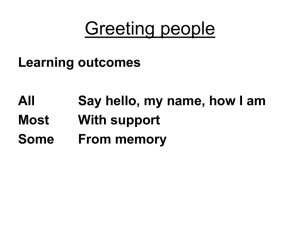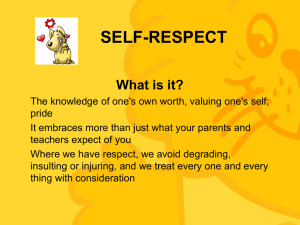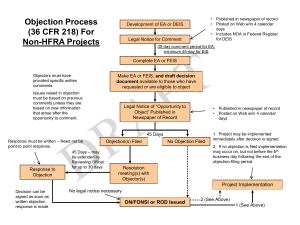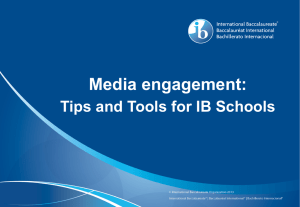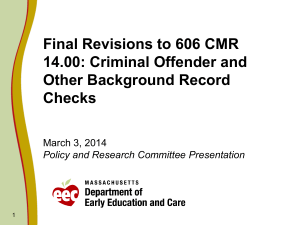Effectively Communicating Data
advertisement
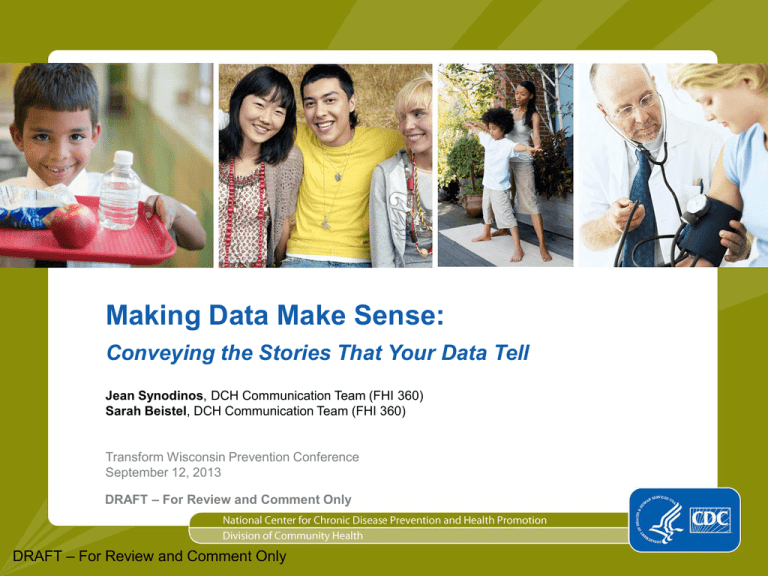
Making Data Make Sense: Conveying the Stories That Your Data Tell Jean Synodinos, DCH Communication Team (FHI 360) Sarah Beistel, DCH Communication Team (FHI 360) Transform Wisconsin Prevention Conference September 12, 2013 DRAFT – For Review and Comment Only DRAFT – For Review and Comment Only 1 Session Objectives • Explore how to connect our data to our stories • Consider our audiences’ preferences when choosing methods for conveying data • Learn how social math can be used to clarify data for many audiences—visually and linguistically • Demonstrate how infographics can help tell the story inherent in data The findings and conclusions in this presentation are those of the authors and do not necessarily represent the views of the Centers for Disease Control and Prevention DRAFT – For Review and Comment Only 2 How Can Data Be Used? • Gloom (things are bad)—Raise or Maintain Awareness • Control and Hope (solution for a problem)— Predict • Success—Evaluation Nelson DE, Hesse BW, Kwon HT. Making data talk. Presented at the 2010 Joint Conference of SOPHE and Prevention Research Centers Program. Available from http://www.sophe.org/Sophe/PDF/2010%20MY/Precon3.pdf DRAFT – For Review and Comment Only 3 Not Everyone Understands Health Information • Results from National Assessment of Adult Literacy • 12% of U.S. adults have proficient health literacy levels • Over 1/3 of U.S. adults have trouble with common health tasks • Any one can have limited health literacy skills— regardless of education level America's Health Literacy: Why We Need Accessible Health Information. An Issue Brief From the U.S. Department of Health and Human Services. 2008. Available from http://www.health.gov/communication/literacy/issuebrief DRAFT – For Review and Comment Only 4 Not Everyone Understands Numbers • Health literacy skills ≠ numeracy skills (ability to understand and use numbers) • Half of population has problems with simple numeric tasks • People can retain 7 (±2) new pieces of information at a time • More data ≠ increase argument strength White RO, Wolff K, Cavanaugh KL, Rothman R. Addressing Health Literacy and Numeracy to Improve Diabetes Education and Care. Diabetes Spectr. 2010 October 2; 23(4): 238–243. Nelson DE, Hesse BW, Kwon HT. Making data talk. Available from http://www.sophe.org/Sophe/PDF/2010%20MY/Precon3.pdf Peters E, Hibbard J, Slovic P, Dieckmann N. Numeracy skill and the communication, comprehension, and use of risk-benefit information. Health Aff (Millwood). 2007 May-Jun;26(3):741-8. DRAFT – For Review and Comment Only 5 Connecting our data to the human story of our work Data ↔ Head Stories ↔ Heart DRAFT – For Review and Comment Only 6 What Do You See? J FKFB INAT OUP SNA SAI RS DRAFT – For Review and Comment Only 7 Now, What Do You See? JFK FBI NATO UPS NASA IRS Context makes all the difference. DRAFT – For Review and Comment Only 8 Percentage of Obese Adults in U.S. (BMI ≥ 30) By Year 2001 2002 2003 21.1 22.2 22.8 2004 2005 23.2 24.4 2006 2006 2008 25.1 26.3 26.6 2009 27.2 2010 27.6 2011 27.8 Source: http://wwwn.cdc.gov/sortablestats DRAFT – For Review and Comment Only Data without stories (human context) leaves audiences with an abstraction that does not prompt them to do something. 9 Stories without data (credibility) may leave audiences moved, but without a sense of direction. DRAFT – For Review and Comment Only 10 It’s All About Our Audiences • • • • • • • • • • Awardee and subawardee leadership teams Community members at large Community leaders Health department staff/divisions Health care providers Other government agencies Business Faith community Schools Parents DRAFT – For Review and Comment Only 11 … And Meeting Their Needs • What does the audience want/need to hear? • Do we have it? • Can we get it? • What presentation(s) of the data will be effective, e.g.: • Linguistic (written, oral) • Visual • Social math (linguistic and/or visual) Different audiences may need to see your data DRAFT – For Review andpresented Comment Only in different ways. 12 Considerations For Conveying Data Simple Emotional Informative Data Presentation Personal Familiar DRAFT – For Review and Comment Only True Concrete 13 65% of people are visual learners, in whole or in part. But the visual must be recognizable and of meaning to our audiences. Image from National DRAFT – ForFoundation Review and Comment Only Science 14 Multiple Ways to Represent Data • The challenge: • Encourage healthier snack choices at theater. • Data report: • A typical medium popcorn at the movies contains 60 grams of saturated fat.* • USDA recommends no more than 20 grams/day of saturated fat.** * Center for Science in the Public Interest, Nov. 2009 ** Dietary Guidelines for 2,000 calorie/day diet http://www.health.gov/dietaryguidelines/dga2010/DietaryGuidelines2010.pdf Would reading this data be likely to impact healthier snack choices at the movies? DRAFT – For Review and Comment Only 15 Illustrating Data: One Way to Go Grams of Fat 70 60 50 40 30 20 10 0 Movie Theater Popcorn 2010 Dietary Guidelines for Americans Is seeing this table more likely to impact consumption of healthier choices? DRAFT – For Review and Comment Only 16 300% A typical medium movie theater popcorn has three times the recommended daily allowance of fat! DRAFT – For Review and Comment Only 17 A typical medium popcorn at the movies “is the same as six eggs with cheddar cheese, four strips of bacon, and four sausage links.” = DRAFT – For Review and Comment Only 18 Connecting with Social Math Data + Audience’s Reality = WOW! DRAFT – For Review and Comment Only “Community residents near a gasoline refinery noted that the plant emits six tons of pollutants per day – or 25 balloons full of toxic pollution for each school-aged child in town.” 19 Connecting With Social Math Social math places data into a real-world context that our audience easily understands. Social math helps audiences immediately understand the “story” inherent in the data. DRAFT – For Review and Comment Only 20 In 1991, enough alcohol was consumed by college students to fill 3,500 Olympic-size swimming pools. The amount spent on alcohol exceeded dollars spent on books. It was far greater than the combined amount of fellowships and scholarships provided to students. DRAFT – For Review and Comment Only Source: Sightline Institute “Social Math: Making Numbers Count” http://daily.sightline.org/2007/12/04/flashcard-no-5-making-numbers-count 21 The tobacco industry spends more money promoting smoking in a week than the Federal government spends on preventing smoking in a year. DRAFT – For Review and Comment Only Source: Sightline Institute “Social Math: Making Numbers Count” http://daily.sightline.org/2007/12/04/flashcard-no-5-making-numbers-count/ and http://www.cdc.gov/tobacco/stateandcommunity/best_practices/ 22 If you are 27 years old or younger, you have never lived through a month that was colder than average. DRAFT – Source: Grist.org: http://grist.org/news/if-youre-27-or-younger-youve-never-experienced-a-colder-than-average-month/ based on NOAA’s State of the Climate 2012: http://www.ncdc.noaa.gov/sotc/global/2012/10 For Review and Comment Only 23 How Social Math Works • Makes an issue (e.g., obesity, tobacco use, chronic disease) urgent and relevant to an audience by comparing the issue numbers to: • Dramatic events (e.g., the number of residents displaced following Hurricane Katrina) • Understandable costs (e.g., the program costs less than a cup of coffee each day) • Current numbers from other issues (e.g., it’s more than one-third of what we spend on prescription medication each year). Find the context that works for your audiences. Use language and/or images to convey. DRAFT – For Review and Comment Only 24 Guiding Questions To Help You • • • • • • Who/what does it impact? How much money does it represent? How much time (lost/found) does it represent? What resources does it use/save? How big/long/wide/short/tall is it? How might it be compared to a place or an event? Make it accurate, dramatic, and appropriate for your audiences. DRAFT – For Review and Comment Only 25 Four Simple Steps 1. Identify the key data point to share with your audience 2. Convert any percentages into numbers 3. Find your comparative data (again, use numbers, not percentages) 4. Create your equation The key to social math: DRAFT – For Review and Comment Only Numbers… not percentages! 26 Example: Obesity in Wisconsin • If… 36.7 percent of adults in Wisconsin are overweight and 26.7 percent are obese (Source: MMWR Surveill Summ. 2013 May 31; 62(1):1247) • And… the total number of adults (over 18) in Wisconsin is 4,409,326 (Source: http://census.gov) • Then… the total number of overweight and obese Wisconsinites is 2,835,197. DRAFT – For Review and Comment Only 27 2.8 Million Adults Would fill Lambeau Field to capacity 39 times—that’s five years’ worth of Green Bay Packer home games! Using your local data, what landmarks might be relevant to your community? DRAFT – For Review and Comment Only 28 Example: Tobacco Use in Wisconsin • If… 19.1% of adults in Wisconsin are current smokers… (Source: MMWR Surveill Summ. 2013 May 31; 62(1):1-247) • And… the total number of adults (over 18) in Wisconsin is 4,409,326 (Source: http://census.gov) • Then the total number of adult smokers is 842,181. DRAFT – For Review and Comment Only 29 The number of adult smokers is equivalent to twenty times the enrollment at the University of Wisconsin-Madison. DRAFT – For Review and Comment Only 30 The number of adult smokers is 16 times the population of LaOnlyCrosse, WI. DRAFT – For Review and Comment 31 Pull Out Your Smart Phone, Tablet, or Laptop! Your Turn: Social Math DRAFT – For Review and Comment Only 32 Exercise: Social Math For the purpose of learning this skill, let us assume that 35.7 percent of residents in your city, town, or county are obese, and these individuals have $1,429 more in annual medical costs. http://www.cdc.gov/obesity/data/adult.html DRAFT – For Review and Comment Only 33 Exercise: Social Math • What do your audiences care about? • Individual concerns • Quality of life for themselves, for loved ones • Health care costs (insurance, out of pocket) • Community concerns • Burden on health care system, other local resources • Perception of community as a good place to live • Business concerns • Lost productivity • Health care costs • Bottom line DRAFT – For Review and Comment Only 34 Exercise: Social Math • First, using your smart phone, tablet, or laptop, find the population of your city, town, or county. Possible sources: • http://census.gov • Wisconsin Department of Workforce Development: http://dwd.wisconsin.gov/oea • County/city/town government Web sites • http://google.com DRAFT – For Review and Comment Only 35 Exercise: Social Math • Next, calculate the number that represents 35.7 percent (rate of obesity) of your local population. • Multiply that number by $1,429 to arrive at estimated health care costs in your community as a result of obesity. Will your audiences care about one or both of these numbers? DRAFT – For Review and Comment Only 36 Exercise: Social Math • Now, research comparative data that will be meaningful to your audience. Think back to guiding questions: • • • • • Who/what does it impact? How much money and/or time does it represent? What resources does it use or save? How big/long/wide/short/tall is it? Can it be compared to a place or an event? How can you state your equation? How might you also visualize it? DRAFT – For Review and Comment Only 37 Infographics: Accurate visual representations of information, data, or knowledge. http://makinghealtheasier.org/newabnormal DRAFT – For Review and Comment Only 38 http://makinghealtheasier.org/burntolearn DRAFT – For Review and Comment Only 39 http://makinghealtheasier.org/getmoving DRAFT – For Review and Comment Only 40 http://www.phi.org/resources/?resource=prevention-means-business DRAFT – For Review and Comment Only 41 Create Infographics Online Piktochart http://piktochart.com DRAFT – For Review and Comment Only Easel.ly http://easel.ly Infogr.am http://infogr.am 42 Infographic Best Practices • Use graphic images that complement your data • Tell a story by drawing the viewer/reader through a beginning, middle, end • Keep your infographic clear and avoid extraneous information that does not directly support your story • Stick to three colors, limit font types Sources: http://www.hhs.gov/digitalstrategy/people-first/power-infographics.html and http://www.smashingmagazine.com/2011/10/14/the-dos-and-donts-of-infographic-design/ DRAFT – For Review and Comment Only 43 National Council of La Raza Infographic • Created in Piktochart • Refined over several months • Defines the issue • Is audience-focused • Includes social math • Includes a clear next step Let’s look closer… DRAFT – For Review and Comment Only 44 Identifies audience, introduces subject. Data show how the audience is disproportionately impacted. Audience learns more about the issue. DRAFT – For Review and Comment Only 45 Social math describes the size of the population impacted. Data drive home the importance of a pap smear. Note how “8 out of 10” is less abstract than “82 percent.” DRAFT – For Review and Comment Only 46 Matches the audience value that “life is precious” The Final Pane Offers a clear next step Addresses possible barriers of cost Provides more information Lists data sources DRAFT – For Review and Comment Only 47 Promote Your Infographic Online Basic Advanced • Find a permanent home for it on your Web site or blog • “Tag” the image so search engines will find it (e.g., Latina pap smear infographic, Latina cervical cancer) • Share on your social media—and ask others to share • Share in an e-newsletter • Create an HTML Embed Code so others can put it on their Web sites * • “Guest” blog about it on relevant blogs • Submit to the many sites that publish infographics * http://blog.hubspot.com/how-to-create-embed-codes-generator-infographic-content-ht DRAFT – For Review and Comment Only 48 DRAFT – For Review and Comment Only 49 The Message Framework • The Message Framework can help you effectively integrate data into your messages. • Specify the situation in your community • Illustrate the landscape • Describe the solution • Provide a clear next step DRAFT – For Review and Comment Only 50 Questions? DRAFT – For Review and Comment Only 51 CDC Data Sources • Sortable Stats: http://wwwn.cdc.gov/sortablestats/ • Behavioral Risk Factor Surveillance System (BRFSS): http://www.cdc.gov/brfss/ • Youth Behavior Risk Surveillance System (YRBS): http://www.cdc.gov/HealthyYouth/yrbs/index.htm • Social Determinants of Health Maps: http://www.cdc.gov/dhdsp/maps/social_determinants_maps.ht m • Data Set Directory of Social Determinants of Health at the Local Level: http://www.cdc.gov/dhdsp/docs/data_set_directory.pdf • Simply Put: http://www.cdc.gov/healthliteracy/pdf/simply_put.pdf DRAFT – For Review and Comment Only 52 Other Data Sources • U.S. Census: http://www.census.gov/ • U.S. Bureau of Labor Statistics: http://stat.bls.gov/oes/home.htm • U.S. Bureau of Economic Analysis: http://www.bea.gov/ • No Child Left Behind: http://nochildleftbehind.gov • U.S. Department of Housing and Urban Development Office of Policy and Research: http://www.huduser.org/portal/ • Community Commons: http://www.communitycommons.org/ Be sure to investigate publicly available state and DRAFT – For Review and Comment Only municipal data as well. 53 Social Math Resources • CDC National Center for Injury Prevention and Control, Adding Power to Our Voices: A Framing Guide for Communicating About Injury (27-33). http://www.cdc.gov/injury/CDCFramingGuide-a.pdf • Center for Health Improvement http://www.chipolicy.org/pdf/TA5.pdf • Department of Community Medicine, University of Connecticut Health Center http://www.commed.uchc.edu/healthservices/mediaadvoc/sld001.htm • Census Bureau Quick Facts http://quickfacts.census.gov/qfd/index.html • FrameWorks Institute, Doing Social Math http://www.frameworksinstitute.org/ezine39.html DRAFT – For Review and Comment Only 54 Infographics Resources • Create online infographics: • Piktochart: http://piktochart.com • Easel.ly: http://easel.ly • Infogr.am: http://infogr.am • Inspiration: • Information is Beautiful: http://www.informationisbeautiful.net/ • Flowing Data: http://flowingdata.com/ • Daily Infographic: http://dailyinfographic.com/ • Visually: http://visual.ly DRAFT – For Review and Comment Only 55 Thank You! DRAFT – For Review and Comment Only 56



